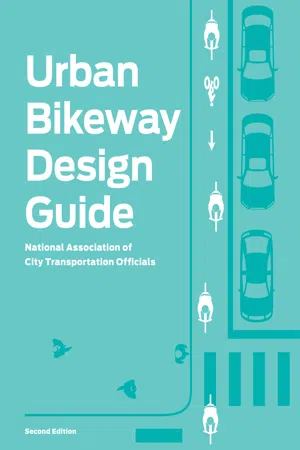![]()
Resources
Notes
Design Guide Project Teams
References
![]()
Notes
| Bike Lanes | CONVENTIONAL BIKE LANES
BUFFERED BIKE LANES
CONTRA-FLOW BIKE LANES
LEFT-SIDE BIKE LANES |
| Cycle Tracks | ONE-WAY PROTECTED CYCLE TRACKS
RAISED CYCLE TRACKS
TWO-WAY CYCLE TRACKS |
| Intersections | BIKE BOXES
INTERSECTION CROSSING MARKINGS
TWO-STAGE TURN QUEUE BOXES
MEDIAN REFUGE ISLAND
CYCLE TRACK INTERSECTION APPROACH |
| Signals | BICYCLE SIGNAL HEADS
HYBRID BEACON FOR BIKE ROUTE CROSSING |
| Signing and Marking | COLORED BIKE FACILITIES
SHARED LANE MARKINGS
BIKE ROUTE WAYFINDING |
| Bicycle Boulevards | ROUTE PLANNING
SIGNS AND PAVEMENT MARKINGS
SPEED MANAGEMENT
VOLUME MANAGEMENT
MINOR STREET CROSSINGS
MAJOR STREET CROSSINGS
OFFSET INTERSECTIONS
GREEN INFRASTRUCTURE |
Introduction
1 http://www.fhwa.dot.gov/environment/bikeped/mutcd_bike.htm
Bike Lanes
CONVENTIONAL BIKE LANES
2 “The recommended width of a bike lane is 1.5m(5 feet) from the face of a curb or guardrail to the bike lane stripe.”
“If the [longitudinal] joint is not smooth, 1.2m (4 feet) of ridable surface should be provided.”
AASHTO. (1999). GUIDE FOR THE DEVELOPMENT OF BICYCLE FACILITIES.
3 “If parking is permitted, … the bike lane should be placed between the parking area and the travel lane and have a minimum width of 1.5 m (5 feet).”
“Where parking is permitted but a parking stripe or stalls are not utilized, the shared area should be a minimum 3.6 m (12 feet) adjacent to a curb face … If the parking volume is substantial or turnover is high, an additional 0.3 to 0.6 m (1 to 2 feet) of width is desirable.”
AASHTO. (1999). GUIDE FOR THE DEVELOPMENT OF BICYCLE FACILITIES.
4 “On new structures [with railings], the minimum clear width should be the same as the approach paved shared use path, plus the minimum 0.6-m (2-foot) wide clear areas.”
AASHTO. (1999). GUIDE FOR THE DEVELOPMENT OF BICYCLE FACILITIES.
5 Markings shall be placed:
• At the beginning of bike lane
• At the far side of all bike path crossings
• At approaches and at far side of all arterial crossings
• At major changes in direction
• At intervals not to exceed 1/2 mile
• At beginning and end of bike lane pockets at approach to intersection
LOS ANGELES BICYCLE PLAN UPDATE (2010).
CHAPTER 5 — TECHNICAL DESIGN HANDBOOK-DRAFT.
6 “A bike lane should be delineated from the motor vehicle travel lanes with a 150-mm (6-inch) solid white line. Some jurisdictions have used a 200-mm (8-inch) line for added distinction.”
AASHTO. (1999). GUIDE FOR THE DEVELOPMENT OF BICYCLE FACILITIES.
7 “An additional 100-mm (4-inch) solid white line can be placed between the parking lane and the bike lane. This second line will encourage parking closer to the curb, providing added separation from motor vehicles, and where parking is light it can discourage motorists from using the bike lane as a through travel lane.”
AASHTO. (1999). GUIDE FOR THE DEVELOPMENT OF BICYCLE FACILITIES.
8 “Since bicyclists usually tend to ride a distance of 0.8-1.0 m (32-40 inches) from a curb face, it is very important that the pavement surface in this zone be smooth and free of structures. Drain inlets and utility covers that extend into this area may cause bicyclists to swerve, and have the effect of reducing the usable width of the lane. Where these structures exist, the bike lane width may need to be adjusted accordingly.”
AASHTO. (1999). GUIDE FOR THE DEVELOPMENT OF BICYCLE FACILITIES.
BUFFERED BIKE LANES
9 “Bicycle lane — the preferential lane-use marking for a bicycle lane shall consist of a bicycle symbol or the word marking BIKE LANE.”
FEDERAL HIGHWAY ADMINISTRATION. (2009). MANUAL ON UNIFORM TRAFFIC CONTROL DEVICES. SECTION 3D.01.
10 Standard guidance for Buffer-separated right-hand side preferential lane buffer configurations (MUTCD 3D.02 03-D):
1. A wide solid double white line along both edges of the buffer space where crossing the buffer space is prohibited.
2. A wide solid single white line along both edges of the buffer space where crossing of the buffer space is discouraged.
FEDERAL HIGHWAY ADMINISTRATION. (2009). MANUAL ON UNIFORM TRAFFIC CONTROL DEVICES. SECTION 3D.02.
11 “When crosshatch markings are used in paved areas that separate traffic flows in the same general direction, they shall be white and they shall be shaped as chevron markings, with the point of each chevron facing toward approaching traffic…”
FEDERAL HIGHWAY ADMINISTRATION. (2009). MANUAL ON UNIFORM TRAFFIC CONTROL DEVICES. SECTION 3B.24.
12 “The longitudinal spacing of the chevrons or diagonal lines should be determined by engineering judgment considering factors such as speeds and desired visual impacts. The chevrons and diagonal lines should form an angle of approximately 30 to 45 degrees with the longitudinal lines that they intersect.”
FEDERAL HIGHWAY ADMINISTRATION. (2009). MANUAL ON UNIFORM TRAFFIC CONTROL DEVICES. SECTION 3B.24.
CONTRA-FLOW BIKE LANES
13 Center line pavement markings, when used, shall be the pavement markings used to delineate the separation of traffic lanes that have opposite directions of travel on a roadway and shall be yellow (3B.01 01).
Two-direction no-passing zone markings consisting of two normal solid yellow lines where crossing the center line markings for passing is prohibited for traffic traveling in either direction (3B.01 04.C).
FEDERAL HIGHWAY ADMINISTRATION. (2009). MANUAL ON UNIFORM TRAFFIC CONTROL DEVICES.
14 “Where there is room for bike lanes on both sides of the street, they should be included to clarify where bicyclists should travel. If there is no room for a full bike lane, other pavement markings or signs should be considered to clarify direction.”
PEDESTRIAN AND BICYCLE INFORMATION CENTER. (2006).
BIKESAFE: BICYCLE COUNTERMEASURE SELECTION SYSTEM.
PUBLICATION NO...
